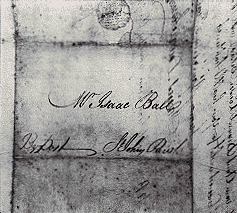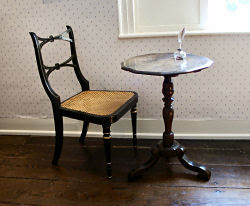

During Jane Austen’s time, letters were written on sheet of paper that were folded and sealed, as in this sample. The recipient of the letter had to pay for the delivery. Therefore, the fewer pages that were used, the less expensive the cost, since the fee was based on the size of a letter and the distance it traveled.
 Envelopes were not used. They would have added an additional sheet of paper and cost more for the recipient. To keep the letter affordable, people also wrote in a cross letter style as shown below.
Envelopes were not used. They would have added an additional sheet of paper and cost more for the recipient. To keep the letter affordable, people also wrote in a cross letter style as shown below. Hand made papers were made in molds, hence one could readily observe the paper marks and ribbing from the parallel wires in the mold. Often these “laid” papers also bore distinctive watermarks. Double click on the image below to view these distinctive markings up close.
Hand made papers were made in molds, hence one could readily observe the paper marks and ribbing from the parallel wires in the mold. Often these “laid” papers also bore distinctive watermarks. Double click on the image below to view these distinctive markings up close. Writing implements included the quill pen, an inkstand filled with ink, pen knife, and sometimes a writing box.
Writing implements included the quill pen, an inkstand filled with ink, pen knife, and sometimes a writing box. Roller blotters made their appearance during the 19th century. Before this time, writers dried wet ink by sprinkling grains of sand over the words.
Roller blotters made their appearance during the 19th century. Before this time, writers dried wet ink by sprinkling grains of sand over the words.
Creating quill pens was an art, since the nib had to be carefully cut with a knife so that the hollow core would hold just the right amount of ink and release it steadily under pressure. If the writer wrote for any length of time, fingers on the writing hand would often become ink stained. Quill pens, most commonly obtained from the wing feathers of a goose, had to be sharpened often with a pen knife. The average quill pen lasted for only a week before it was discarded.
 After folding the paper, a sender would seal the letter with a custom wax seal stamp, that in some instances bore the family crest or the sender’s initials. The address on the outside remained simple, directing the bearer of the letter to the city or town, street, and the name of the receiver.
After folding the paper, a sender would seal the letter with a custom wax seal stamp, that in some instances bore the family crest or the sender’s initials. The address on the outside remained simple, directing the bearer of the letter to the city or town, street, and the name of the receiver. This is a photo of Jane Austen's writing table and chair at Chawton, where she wrote the bulk of her novels and, I imagine, her letters as well.
This is a photo of Jane Austen's writing table and chair at Chawton, where she wrote the bulk of her novels and, I imagine, her letters as well.Find out more about letter writing here:
The Writing Implement of Jane Austen: The Quill Pen
London Mail and Postal Service: The Georgian Index
18th and 19th Century Wooden Seal Boxes
Cutting a Quill Pen

3 comments:
Very interesting! I think it is a shame that people rarely hand write letters anymore. I love doing so and receiving one in the mail is always a treat.
Great insight to a very important part of life during the Regency. You can see why good penmenship and being a faithful correspondent were important during this time. A valuable skill for the mistress of a grand estate.
It's always been a wonder to me that Jane Austen could have written anything on that tiny round table. A letter, maybe, but whole novels? Where did she put her elbows?
Post a Comment